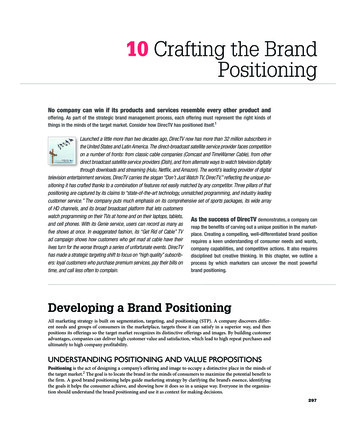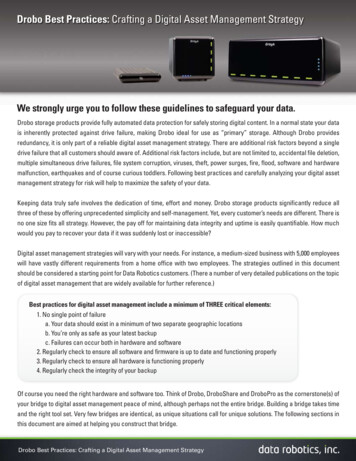
Transcription
10 Crafting the BrandPositioningNo company can win if its products and services resemble every other product andoffering. As part of the strategic brand management process, each offering must represent the right kinds ofthings in the minds of the target market. Consider how DirecTV has positioned itself.1Launched a little more than two decades ago, DirecTV now has more than 32 million subscribers inthe United States and Latin America. The direct-broadcast satellite service provider faces competitionon a number of fronts: from classic cable companies (Comcast and TimeWarner Cable), from otherdirect broadcast satellite service providers (Dish), and from alternate ways to watch television digitallythrough downloads and streaming (Hulu, Netflix, and Amazon). The world’s leading provider of digitaltelevision entertainment services, DirecTV carries the slogan “Don’t Just Watch TV, DirecTV,” reflecting the unique positioning it has crafted thanks to a combination of features not easily matched by any competitor. Three pillars of thatpositioning are captured by its claims to “state-of-the-art technology, unmatched programming, and industry leadingcustomer service.” The company puts much emphasis on its comprehensive set of sports packages, its wide arrayof HD channels, and its broad broadcast platform that lets customerswatch programming on their TVs at home and on their laptops, tablets,As the success of DirecTV demonstrates, a company canand cell phones. With its Genie service, users can record as many asreap the benefits of carving out a unique position in the marketfive shows at once. In exaggerated fashion, its “Get Rid of Cable” TVplace. Creating a compelling, well-differentiated brand positionad campaign shows how customers who get mad at cable have theirrequires a keen understanding of consumer needs and wants,lives turn for the worse through a series of unfortunate events. DirecTVcompany capabilities, and competitive actions. It also requireshas made a strategic targeting shift to focus on “high quality” subscribdisciplined but creative thinking. In this chapter, we outline aers: loyal customers who purchase premium services, pay their bills onprocess by which marketers can uncover the most powerfulbrand positioning.time, and call less often to complain.Developing a Brand PositioningAll marketing strategy is built on segmentation, targeting, and positioning (STP). A company discovers different needs and groups of consumers in the marketplace, targets those it can satisfy in a superior way, and thenpositions its offerings so the target market recognizes its distinctive offerings and images. By building customeradvantages, companies can deliver high customer value and satisfaction, which lead to high repeat purchases andultimately to high company profitability.Understanding Positioning and Value PropositionsPositioning is the act of designing a company’s offering and image to occupy a distinctive place in the minds ofthe target market.2 The goal is to locate the brand in the minds of consumers to maximize the potential benefit tothe firm. A good brand positioning helps guide marketing strategy by clarifying the brand’s essence, identifyingthe goals it helps the consumer achieve, and showing how it does so in a unique way. Everyone in the organization should understand the brand positioning and use it as context for making decisions.297M10 KOTL2621 15 GE C10.INDD 2973/11/15 5:22 PM
298PART 4 Building Strong BrandsTable 10.1Examples of Value PropositionsCompany and ProductTarget CustomersValue PropositionHertz (car rental)Busy professionalsFast, convenient way to rent the right typeof a car at an airportVolvo (station wagon)Safety-conscious upscale familiesThe safest, most durable wagon in whichyour family can rideDomino’s (pizza)Convenience-minded pizza loversA delicious hot pizza, delivered promptly toyour doorA useful measure of the effectiveness of the organization’s positioning is the brand substitution test. If, in somemarketing activity—an ad campaign, a viral video, a new product introduction—the brand were replaced by acompetitive brand, then that marketing activity should not work as well in the marketplace. A well-positionedbrand should be distinctive in its meaning and execution. If a sport or music sponsorship, for example, would workas well if it were for a leading competitor, then either the positioning is not sharply defined well enough or thesponsorship as executed does not tie closely enough to the brand positioning.A good positioning has one foot in the present and one in the future. It needs to be somewhat aspirational sothe brand has room to grow and improve. Positioning on the basis of the current state of the market is not forwardlooking enough, but at the same time, the positioning cannot be so removed from reality that it is essentially unobtainable. The real trick is to strike just the right balance between what the brand is and what it could be.One result of positioning is the successful creation of a customer-focused value proposition, a cogent reasonwhy the target market should buy a product or service. As introduced in Chapter 1, a value proposition capturesthe way a product or service’s key benefits provide value to customers by satisfying their needs. Table 10.1 showshow three companies—Hertz, Volvo, and Domino’s—have defined their value proposition through the years withtheir target customers.3Positioning requires that marketers define and communicate similarities and differences between theirbrand and its competitors. Specifically, deciding on a positioning requires: (1) choosing a frame of reference byidentifying the target market and relevant competition, (2) identifying the optimal points-of-parity and pointsof-difference brand associations given that frame of reference, and (3) creating a brand mantra summarizingthe positioning and essence of the brand.Choosing a Competitive Frameof ReferenceThe competitive frame of reference defines which other brands a brand competes with and which should thus bethe focus of competitive analysis. Decisions about the competitive frame of reference are closely linked to targetmarket decisions. Deciding to target a certain type of consumer can define the nature of competition because certain firms have decided to target that segment in the past (or plan to do so in the future) or because consumers inthat segment may already look to certain products or brands in their purchase decisions.Identifying Competitors A good starting point in defining a competitive frame of reference forbrand positioning is category membership—the products or sets of products with which a brand competes andthat function as close substitutes. It would seem a simple task for a company to identify its competitors. PepsiCoknows Coca-Cola’s Dasani is a major bottled-water competitor for its Aquafina brand; Wells Fargo knows Bank ofAmerica is a major banking competitor; and Petsmart.com knows a major online retail competitor for pet foodand supplies is Petco.com.The range of a company’s actual and potential competitors, however, can be much broader than the obvious. Toenter new markets, a brand with growth intentions may need a broader or maybe even a more aspirational competitive frame. And it may be more likely to be hurt by emerging competitors or new technologies than by currentcompetitors.The energy-bar market created by PowerBar ultimately fragmented into a variety of subcategories, includingthose directed at specific segments (such as Luna bars for women) and some possessing specific attributes (suchM10 KOTL2621 15 GE C10.INDD 2983/11/15 5:22 PM
Crafting the Brand Positioning chapter 10299as the protein-laden Balance and the calorie-control bar Pria). Each represented a subcategory forwhich the original PowerBar may not be as relevant.4Firms should broaden their competitive frame to invoke more advantageous comparisons.Consider these examples: In the United Kingdom, the Automobile Association positioned itself as the fourth “emergencyservice”—along with police, fire, and ambulance—to convey greater credibility and urgency.The International Federation of Poker is attempting to downplay some of the gambling imageof poker to emphasize the similarity of the card game to other “mind sports” such as chess andbridge.5The U.S. Armed Forces changed the focus of its recruitment advertising from the military aspatriotic duty to the military as a place to learn leadership skills—a much more rational thanemotional pitch that better competes with private industry.6We can examine competition from both an industry and a market point of view.7 An industryis a group of firms offering a product or class of products that are close substitutes for one another.Marketers classify industries according to several different factors, such as the number of sellers;degree of product differentiation; presence or absence of entry, mobility, and exit barriers; coststructure; degree of vertical integration; and degree of globalization.Using the market approach, we define competitors as companies that satisfy the same customerneed. For example, a customer who buys a word-processing software package really wants “writingability”—a need that can also be satisfied by pencils, pens, or, in the past, typewriters. Marketersmust overcome “marketing myopia” and stop defining competition in traditional category andindustry terms.8 Coca-Cola, focused on its soft drink business, missed seeing the market for coffeebars and fresh-fruit-juice bars that eventually impinged on its soft-drink business.The market concept of competition reveals a broader set of actual and potential competitorsthan competition defined in just product category terms. Jeffrey Rayport and Bernard Jaworskisuggest profiling a company’s direct and indirect competitors by mapping the buyer’s steps in obtaining and using the product. This type of analysis highlights both the opportunities and the challenges a company faces.9Source: RGB Ventures LLC dba SuperStock/Alamy The U.S. Armed Forces is putting moreemphasis on its opportunities forleadership and career developmentvs. patriotic appeals for serving.Analyzing Competitors Chapter 2 described how to conduct a SWOT analysis that includes acompetitive analysis. A company needs to gather information about each competitor’s real and perceived strengthsand weaknesses.Table 10.2 shows the results of a company survey that asked customers to rate its three competitors, A, B, and C, onfive attributes. Competitor A turns out to be well known and respected for producing high-quality products sold by agood sales force, but poor at providing product availability and technical assistance. Competitor B is good across theboard and excellent in product availability and sales force. Competitor C rates poor to fair on most attributes. This resultsuggests that in its positioning, the company could attack Competitor A on product availability and technical assistanceand Competitor C on almost anything, but it should not attack B, which has no glaring weaknesses. As part of this competitive analysis for positioning, the firm should also ascertain the strategies and objectives of its primary competitors.Source: Blend Images/AlamyThe International Federation ofPoker is putting more emphasison the intellectual rewards fromplaying poker vs. the thrill fromgambling.M10 KOTL2621 15 GE C10.INDD 2993/11/15 5:22 PM
300PART 4 Building Strong BrandsTable 10.2Customers’ Ratings of Competitors on Key Success abilityTechnicalAssistanceSelling StaffCompetitor AEEPPGCompetitor BGGEGECompetitor CFPGFFNote: E excellent, G good, F fair, P poor.Once a company has identified its main competitors and their strategies, it must ask: What is each competitorseeking in the marketplace? What drives each competitor’s behavior? Many factors shape a competitor’s objectives, including size, history, current management, and financial situation. If the competitor is a division of alarger company, it’s important to know whether the parent company is running it for growth or for profits, ormilking it.10Finally, based on all this analysis, marketers must formally define the competitive frame of reference to guidepositioning. In stable markets where little short-term change is likely, it may be fairly easy to define one, two, orperhaps three key competitors. In dynamic categories where competition may exist or arise in a variety of differentforms, multiple frames of reference may be present, as we discuss below.Identifying Potential Points-of-Differenceand Points-of-ParityOnce marketers have fixed the competitive frame of reference for positioning by defining the customertarget market and the nature of the competition, they can define the appropriate points-of-difference and pointsof-parity associations.11Points-of-Difference Points-of-difference (PODs) are attributes or benefits that consumers stronglyassociate with a brand, positively evaluate, and believe they could not find to the same extent with a competitivebrand.Associations that make up points-of-difference can be based on virtually any type of attribute or benefit.12 LouisVuitton may seek a point-of-difference as having the most stylish handbags, Energizer as having the longest-lastingbattery, and Fidelity Investments as offering the best financial advice and planning.Strong brands often have multiple points-of-difference. Some examples are Apple (design, ease-of-use, andirreverent attitude), Nike (performance, innovative technology, and winning), and Southwest Airlines (value, reliability, and fun personality).Creating strong, favorable, and unique associations is a real challenge, but an essential one for competitivebrand positioning. Although successfully positioning a new product in a well-established market may seem particularly difficult, Method Products shows that it is not impossible.13Method ProductsThe brainchild of former high
brand positioning is category membership—the products or sets of products with which a brand competes and that function as close substitutes. It would seem a simple











